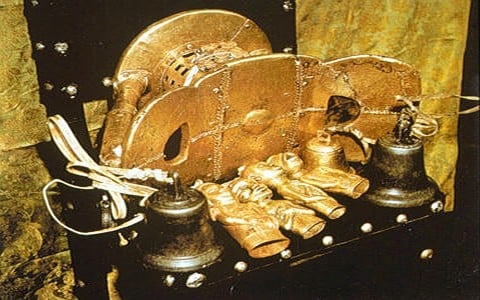 |
| French Illustration of an Ashanti Scout (1884) |
I hope you enjoyed this week's episode of the History of Africa podcast. This episode focused on the reorganization of the Ashanti army that took place after Osei Tutu's return in 1695. As of his return, the Ashanti people were still disunited. While the multiple Ashanti kingdoms fought as allies against their common enemy the Dormaa, they were still esssentially multiple armies under one banner. However, Osei Tutu sought to transform this status quo. In order to prepare for the inevitable war against the Denkyira, the King of Kumasi, Osei Tutu, ordered the reorganization of the Ashanti's current cobbled together army of local militias into a single, unified force of professional soldiers. Additionally, Osei Tutu sought to educate this new army in modern Akan tactics, replacing the old manner of traditional battle.
 |
| Fante soldiers, which practiced similar modern, firearm dependent tactics to the Denkyira or Akwamu. |
These new tactics would be necessary if the Ashanti were going to stand up to the Denkyira. Like the other states in the southern region of Ghana, the Denkyira had adopted modern tactics and fully integrated firearm use into their wartime strategies. If the Ashanti tried to face the modern, gun-wielding tactics of the Denkyira with traditional, sword-wielding Akan tactics, they would be crushed.
To teach his army in this modern way of warfare, Osei Tutu conscripted the Akwamu soldiers who had accompanied him on his return to Kumasi. Like the Denkyira, the Akwamu had long adapted modern firearms focused tactics and had used them in their own successful wars of conquest.

The Ashanti army was drilled in the Akwamu strategic doctrine. Akwamu strategy hinged on encircling the enemy. The army was divided into several components. A scouting regiment tracked enemy forces, sabotaged their paths, and launched guerrilla style sniper attacks. The forward guard, composed of the best trained members of the Ashanti army would fiercely attack the enemy, forcing the enemy into a static defensive position. The four wings would then move around the pinned enemy, attempting to encircle the enemy. The main body provided a manpower reserve for whichever part of the army needed reinforcements. Meanwhile, the rear guard of the army sat at the back of the force, protecting against encirclement. Officers and nobility were protected by a specialized group of bodyguards meant to protect these critical people from being hurt or killed in a potential defeat. Finally, the army was accompanied by a horde of medics, engineers, supply transporters, and foragers, meant to support the army in non-combat matters.
While the Ashanti were still new to this type of warfare were far from perfectly implementing this doctrine. Despite this, the Ashanti put this new style of warfare to great use against the Dormaa, decisively defeating their eastern rival when the Dormaa tried to invade Kumasi. But, compared to the coming threat, the Dormaa were small change. During our next episode, we'll see how this new army fares against the centuries old hegemons of the Ghanaian forest region, the Denkyira.





